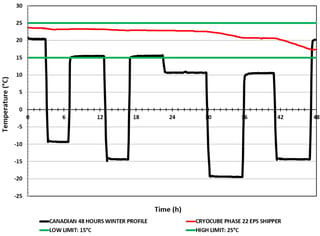
A major topic of discussion in cold chain shipping this time of year is how to prevent items from freezing, rather than how to keep them cold. “Cold chain” as a term is a bit of a misnomer, as there is a wide array of temperature requirements that result in the need for temperature-controlled packaging. Whether the range is specified as 2°C to 8°C, 2°C to 30°C or 15°C to 25°C, one thing that remains a common factor is a “do not freeze” specification. Often, 2°C is placed as the low temperature specification for these packages as it is close to freezing but also above 0°C enough to account for variances in measuring equipment accuracy and differences in the product formulation.
Scientifically speaking, “freezing” really refers to a material going from liquid to solid, which can occur at different temperatures — 0°C is just the temperature that water happens to freeze. The operative thing to keep in mind for temperature control applications is that the material will maintain its phase change temperature for a long period of time while it is undergoing a change in state (i.e., between solid and liquid).
Choosing the right refrigerant
The vast majority of temperature-controlled packages utilize water-based gel packs in their solid state as the primary refrigerant. This means that the gel pack needs to be conditioned well below 0°C in order to solidify it prior to use, and it can easily freeze the product if placed in direct contact.
This results in many designs where water-based gels are also placed as buffers between the product and the frozen gel packs to offset the temperature. This works fine in most situations, but has the conceptual weakness of relying on a material that naturally maintains 0°C to keep the product from freezing. For situations where extra protection is needed, a Phase Change Material (PCM) that has a freezing point above the low temperature limit is often utilized.
For a product that needs to be held at Controlled Room Temperature (CRT), which is typically stated as 15°C to 25°C, a PCM such as Cryopak’s Phase 22 would be necessary. Phase 22 has a freezing point of 22°C and is ideal to act as a heat source in cold weather conditions. The PCM is stored at an elevated temperature to fully melt it, and is then placed into the temperature-controlled package in its liquid state. When the package is exposed to cold temperatures, the PCM begins to solidify and maintains 22°C throughout the duration.
Below is an example of a test graph showing Phase 22 used as the PCM in Cryopak’s Cryocube CRT shipping solution:

The temperature profile is intended to represent a cold weather day in Canada that a small parcel shipment might experience. The Phase 22 is able to resist the very cold ambient conditions and maintain the temperature of the product payload above the 15°C lower limit. Since Phase 22 freezes at room temperature, the product also holds room temperature inside the package. The internal measurements show the 22°C phase change temperature being maintained with a simple EPS (Expanded Polystyrene) container around it. Since water does not freeze until it reaches 0°C, it is not well-suited to this sort of application.
Cryopak has engineered many packaging designs with Phase 22 and other PCMs to overcome similar challenges, and looks forward to new opportunities to help protect products from freezing using these methodologies.
Contact us today to see how we can help you protect your shipments against the cold winter temperatures.




